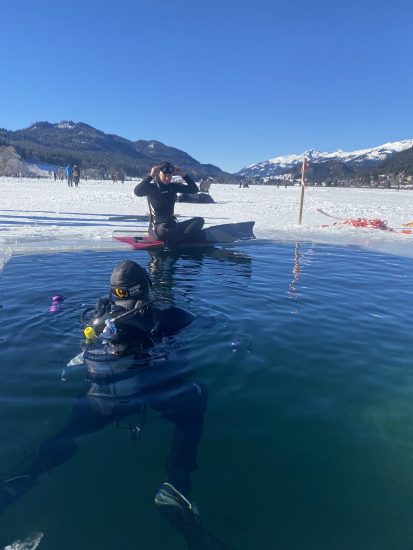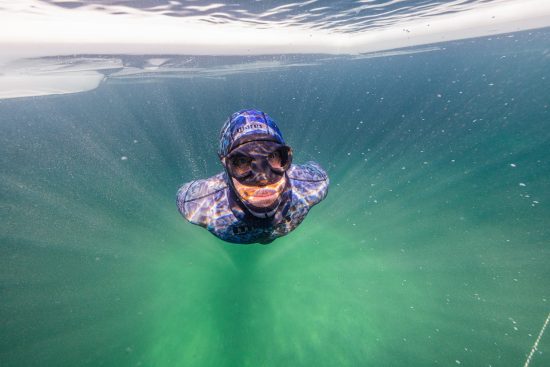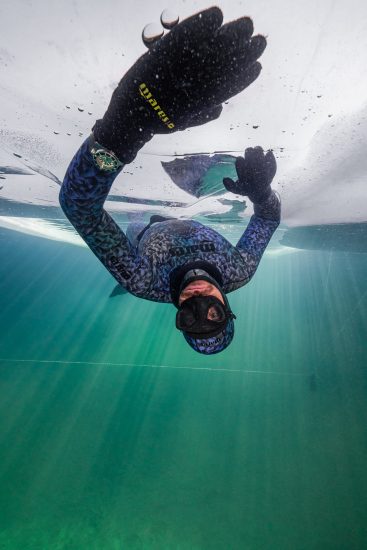Diving under ice is a huge challenge both for the diver and their equipment. This is the third time I have organized the 'Under Ice - Freediving Challenge' at Lake Weissensee in Austria. After several years of breaking world records under ice, I longed to return to the fantastic Carinthia region, mostly to do photoshoots for my sponsors, especially Mares and Davosa watches, because pictures of a freediver under ice are rare and always spectacular. Sunlight penetrating through holes in the ice or even just breaking through the layer of ice creates indescribable imagery, but depending on the nature of the ice, you can also take nice photos from above, looking upwards as if through a glass window, or find ice with nice marble patterns. It's exciting to see what the ice will be like, but of course the conditions are always rough.
I wanted to share this powerful experience with my friends and acquaintances, so a few years ago I held the first events for experienced freedivers. Demand was high, and after the second year, even an additional event was fully booked.
There is always a photographer with me. From my own photoshoots under ice we have created some fantastic, unique pictures. Pictures under ice are difficult to take for many reasons, but the results are always spectacular. This year, Marcus Auwärter of 'Aui Photography' came along. He's a nice guy and also at home in the Mares family as an ambassador. I had gotten to know him a few weeks earlier in Egypt. He worked very well in warm water, but how would he work under ice?
Diving under a sheet of ice is an unfamiliar and extreme challenge for anyone. The impenetrable layer of ice makes it impossible to surface in the event of panic. As soon as you dive under ice for the first time, your inner critic starts talking to you. Our minds are set on life support and not taking life-threatening risks, however, if you accept the challenge and can deal with it in a relaxed manner, this becomes anchored in your consciousness and other critical situations are easier to master. As relaxation is a basic requirement for freediving, participants are taught breathing and mental relaxation techniques to dive confidently and calmly. Nobody is overstrained, and the emphasis on safety provides calm and balance.
The conditions are harsh, 2°C under ice and - 4°C in the air. It's very cold, even with the bright sunshine. What are my equipment recommendations?
I am a huge fan of the
Mares Polygon 80/65 mm suit. I've been wearing it under ice since it came out, on dives in the lake in winter and of course on my trip to see orcas in Norway in November 2023. The water doesn't feel cold for a long time, and even after a while in cold water you don't feel cold. Neoprene socks are important, I use the
Flex Gold socks in 5mm and the
Flex Gold gloves, also in 5mm. When I leave the water, I slip into my Crocs, because they insulate perfectly against the cold ice you spend the whole day on.
What did photographer Marcus think?
"The biggest enemy for us is of course the cold, as Nik already mentioned the water is 2°C. It's important to have the right equipment and not get too cold due to passing several hours in the water. In this case, I have complete confidence in the Mares XR KEVLAR drysuit.
In combination with a
Mares Base Layer, the Mares XR Extreme Undersuit and the
Ultraskin Socks, it was no problem spending several hours at and in the ice hole, photographing and filming the participants of Nik's ice diving event.
The most important thing for us photographers is to keep our hands "warm" to operate the camera. Cold hands/fingers and thick gloves is not a good combination. Here, like Nik, I relied on the 5mm
Flex Gold gloves, which kept me warm during the entire mission and allowed me to carry out my work.
As with the drysuit, I rely on the Mares XR range for the regulator. In this case, I had
two 28 XR first stages and two 28 HR second stages which always kept me safely supplied with air in these adverse conditions. To protect my head from the cold, I also used the
7mm Mares XR3 Dry Smooth hood.
I opted for the Mares
Dragon SLS jacket which allowed me to work comfortably both on and below the surface, and had enough space to accommodate the amount of lead required for dry suit diving. The thick stainless steel D-rings allow the camera to be attached securely with a coiled cable, even when wearing thick gloves.
Icy conditions are also tough on equipment. The cold is also one of the biggest enemies for technology, especially the batteries of the cameras and lamps/flashes. The performance and capacity of modern Li-Ion batteries decreases rapidly at low temperatures. It is therefore important to always try to keep the batteries warm.
Furthermore, it is important to always "store" the camera in water, because using the camera in cold water heats up the air inside the underwater housing. If you place the camera next to the ice hole, for example, condensation will form inside the dome port within a very short time, causing it to fog up. In the worst-case scenario, this could be so severe that drops form inside, which would make it impossible to continue working, making it necessary to open the housing, which we naturally want to avoid in these conditions.
The photography itself is different than in warmer waters, you have to fight against time and the cold. The participants only have a limited amount of time in the water due to the cold, so it is extremely important to discuss the shoot and the poses of the participants in detail in advance so that we don't waste time in the water. We can't repeat scenes or poses indefinitely, so the briefing is one of the most important parts of photographing under ice.
Another very important point is the sediment in the water. Due to the very shallow water, it is inevitable that the participants will stir up sediment from the bottom from time to time. The swirling sediment remains in the water for hours and makes top shots under ice almost impossible. This is reflected in a snow flurry in pictures and videos. With pictures, you often still have the opportunity to "save" a top shot in post-production, but with a video, it is actually impossible to fix this in post-production. It is therefore extremely important to point this out to the participants and brief them accordingly. That's also why we always try to shoot the important pictures/videos in the morning when we're on such photoshoots, so that we don't have a problem with the sediment later, but it usually can't be completely avoided.
If you keep all this in mind, you have a good chance of taking great pictures/videos of freedivers under ice."
Written by
Nik
Date
29th February 2024
Also by Nik
Filter original posts by language:
Translate whole page (Powered by Google Translate):
We use cookies to ensure that we give you the best experience on our website. If you continue to use this site we will assume that you are happy with it.Ok








 Nik
Nik 29th February 2024
29th February 2024